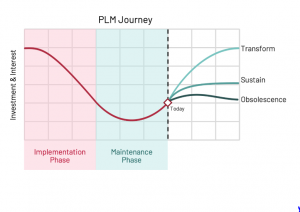Is your PLM aging gracefully?
What to do when your PLM doesn't meet your needs
What comes to mind when you think of your product lifecycle management (PLM) system? It should be a powerful foundational tool that serves to drive your development.
If you've had PLM for longer than 10 years, it might be showing signs of strain, is disconnected from the tools teams are actually using to do their work, takes significant technical load to update, or is otherwise failing to keep up with your business needs.
Adding to the pains of this current state are the emerging complications from your organization, customers and the business environment at large.
- Pressure for leaner, faster teams: Teams are being asked to be more responsive to their end consumer, bring more innovation, cut time out of the development cycle and accomplish more with less.
- Workforce expectations and tech-native talent: The wide availability of advanced consumer technologies that we use in our private lives raises expectations of tools in the workplace. People are accustomed to social media and shopping experiences that automatically come with suggestions on related products. A post on social media comes with suggestions on how to make the content more engaging. Your workforce will increasingly expect their tools to be seamless while enabling them to do their best, most innovative and value-adding work.
- Reduced resources for PLM: As companies realize the latter phases of their PLM roadmaps, budgets are sized for maintenance as the focus shifts to other tools. This shift impacts both the scale of feasible system changes as well as the allocation of resources. Maintenance budgets accommodate minor enhancements but fall short of addressing substantial improvements or larger transformations. The reduction in budget also translates to a loss of the change network that previously supported PLM. As PLM is one of the few enterprise tools that touches cross-functional teams end-to-end, the loss of support is felt end-to-end too.
External evolutions in the marketplace have their own set of impacts:
- Regulatory impacts: Environmental awareness, social awareness and the increasing complexity of the regulatory landscape obligates brands to not only expand the depth of data capture within their product development process and supply chain partners, but also look at scalable ways to reach further into the extended supply chain to harvest the information they need, manage risk and ensure growth.
- The rise of savvy consumers: The consumer-product data gap is shrinking. Consumers are more informed and discerning about what they buy, how it’s made and how it came to them. The transparency they expect about the product creation process includes increased interest in materials and dyes, fit measurements, product quality, sustainability claims and vendor and extended supply chain ethics. Adapting to serve up this information is key to maintaining relevance.
- Software innovation: Like you, PLM software vendors and emerging point solutions are reading the market. They are introducing suites of tools designed to enhance user productivity, adapt to more flexible product creation models, bring decision support front and center, and integrate more easily with the extended ecosystem end to end.
Why is this a problem?
All of this has created an environment where mature PLM clients and capability owners are scrambling to respond and comply with data requirements, adapt and modernize their ecosystems and decide where to invest in order to keep up with the pace of change.
This puts pressure on brands who aren’t positioned to respond, have limited budget, or need to make the case for new investment. Brands who chose to build their own solutions have an additional choice to make: Do they double down and invest in their own IT product support teams and operate them like a mini software company or do they start fresh with an “off the shelf” PLM and leverage the innovations of others?
So where do we go from here?
You are at decision point. During implementation, strategy was clear and attention and investment in PLM was high. Then, system changes stabilized as you finished out your roadmap and entered the maintenance phase. Emerging internal and external pressures have converged to bring you to a decision point: Do you stay on your current maintenance path? Do you look for incremental improvements and ways to stretch your existing resources? Or do you recognize the need to invest again to get ahead of emerging pressures, to modernize, connect and really transform at scale?
Taking no action requires no additional investment and still includes maintenance enhancements, but it is hardly the safest route. This option doesn’t help you respond to emerging pressures and will ultimately put your ecosystem on the road to obsolescence.

Small investments in incremental improvements can help to optimize your solution, lift the burden on your team’s resources and increase the ability to sustain your ecosystem over a longer period. Small investments may include:
- Checking your foundation: You may be able to address additional use cases and challenges without bringing on new solution sets by looking at adjacent capabilities. Any traditional PLM has the capability to provide most of the data to comply with existing regulations and integrate to feed other tools, but is this what yours does? There may be data gaps depending on how it was set up and how it is currently being used.
- Exploring cloud and managed services to multiply your resources: Whether you are managing an aging, unsupported or custom-built PLM, transitioning to the cloud and engaging managed services presents a strategic opportunity that can free up costly resources to concentrate on supporting core business objectives. Cloud services improve up-time, provide redundancy and disaster recovery, improve the ability to apply updates, and more easily connect to cloud-based applications and analytics platforms. Managed services gives you proactive monitoring, predictable costs and steady deployment of backlog enhancements, all backed by teams of experienced professionals.
- Leveraging your software provider: Your software provider likely offers low/no cost services to help you identify where improvements to the solution you already own can dramatically improve performance and the end-user experience. This may include anything from quick tips and advanced usage techniques to configuration, infrastructure and performance tuning.
Achieving transformation at scale requires a larger investment:
- Explore going out of the box: If you purchased “off the shelf” software and then heavily customized it, explore if some of those functions may now be available out of the box. De-customizing lowers the overall cost of ownership and makes you more capable to metabolize enhancements from your software provider.
If your foundation feels too fragmented to move forward but the thought of ripping and replacing feels daunting, know that most established PLM software vendors now offer more value-oriented, pre-configured solutions that allow for growth and are ready to plug in. The days of extended projects with traditional requirements gathering and customer-led solution design have long passed.
- Make it seamless: PLM doesn’t need to be the home for everything, but connecting your planning, DPC, PLM and collaboration tools reduces errors and manual data synchronization from teams. It also creates a backbone for collaboration, visualization and analytics tools to help you pivot to a modern work environment.
- Optimize digital workflows: Take a holistic look at how assets and data can serve multiple parallel and extended purposes. Many brands who explored DPC to land designs in pockets of their business are also now leveraging these tools in an expanded digital product lifecycle to improve decision making, reduce data entry, transform calendars and create time for teams to do their best work.
- Leverage timely, actionable, data-driven insights: Teams leveraging data-driven insights will work confidently and efficiently as they balance the art and the science. Effective usage requires timeliness, relevance and excellent data quality; a disruption in any of this can turn insights into noise for teams that are aiming for efficiency. Aligning your business process and insights with available levers is essential to avoiding the churn that new information can bring. Tools that make the data easily accessible and actionable are also more likely to be used.
- Clarify your traceability and sustainability plan: Define and prioritize which regulatory, traceability and sustainability initiatives will most impact your business and resonate with your customers. Evaluate the ability of your enterprise landscape to respond to data requirements. Identify the most efficient way to ensure consistent data capture, at scale, going forward.
Naturally, the key to choosing the right path is balancing risk versus reward, defining and prioritizing the problems you need to solve, and evaluating your capabilities to deliver.
With the right direction and prioritization and the right functional, technical and change management expertise, any of the initiatives above could be delivered in just a few months. This means that by choosing the right path, you could have a more capable team and a more connected and efficient PLM ecosystem six months from now.

